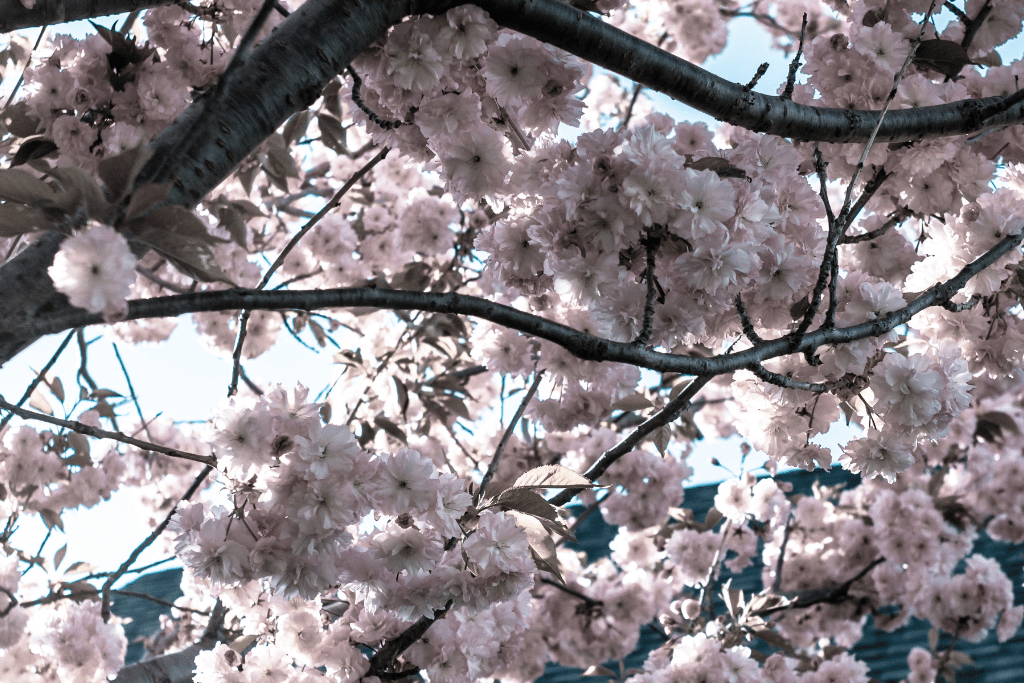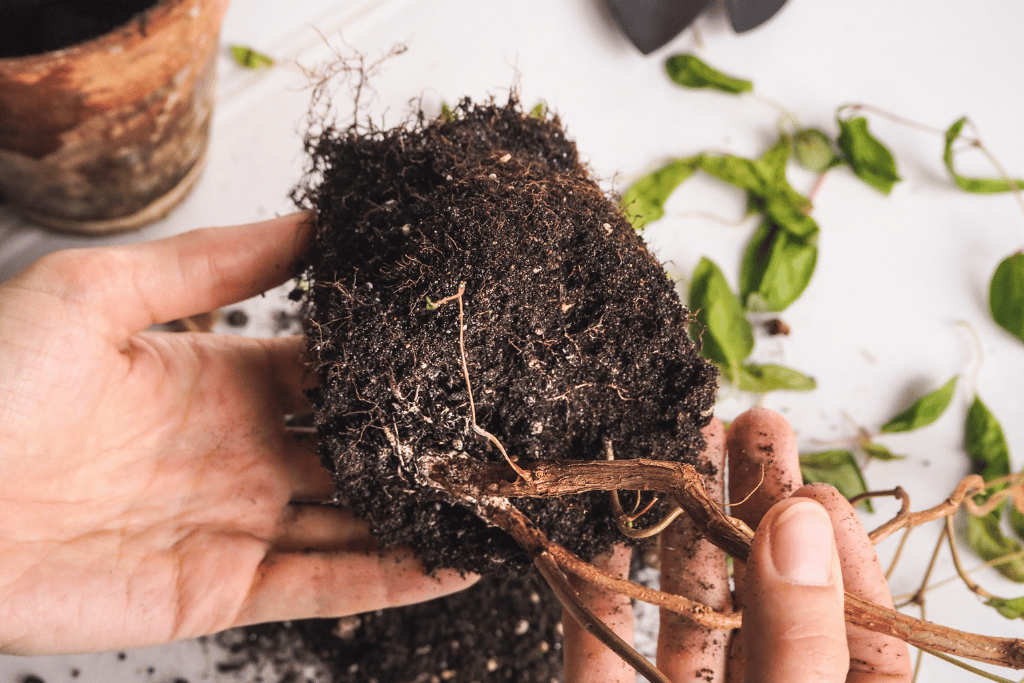
Ever been drawn to the striking color of lavender but find it tricky to grow in your area? Luckily, plenty of sneaky substitutes out there capture the essence of lavender without all the fuss.
Whether you’re looking for a low-maintenance ground cover, a bold statement plant, or a fragrance addition to your patio, there’s a lavender doppelganger for every style and space.
In this article, we will take a deep dive into the world of plants that look like lavender and explore their many benefits and uses.
How to Easily Identify Lavender Plants
To identify Lavender; there are a few characteristics to watch out for. Firstly, Lavender plants have spear-shaped leaves that are typically grayish-green in color. The leaves grow in opposing pairs along a woody stem that varies in height from a few inches to several feet.
The following detail is the significant telltale sign, which is its flowers. Lavender produces distinctive flowers that grow in tight clusters at the top of the stems. Lavender flowers consist of four petals arranged in a tubular shape around the central spike. The two petals at the top form a sort of hood, while the two petals at the bottom are elongated to form a lip. This structure encloses the flower’s reproductive organs, making it easier for pollinators like honey bees and butterflies to access the nectar.
One of the beauties of lavender is that it comes in shades of purple, blue, and pink, and all are highly fragrant. Because of their sweet floral aroma, they are often used in perfumes, soaps, and other fragrances.
When in doubt, rubbing a leaf or flower between your fingers and inhaling deeply is a good way to confirm that you have found a Lavender plant.
So now you know how to detect the real deal Lavender plant, let’s take a look at the plants that look like Lavender.
1. Russian Sage
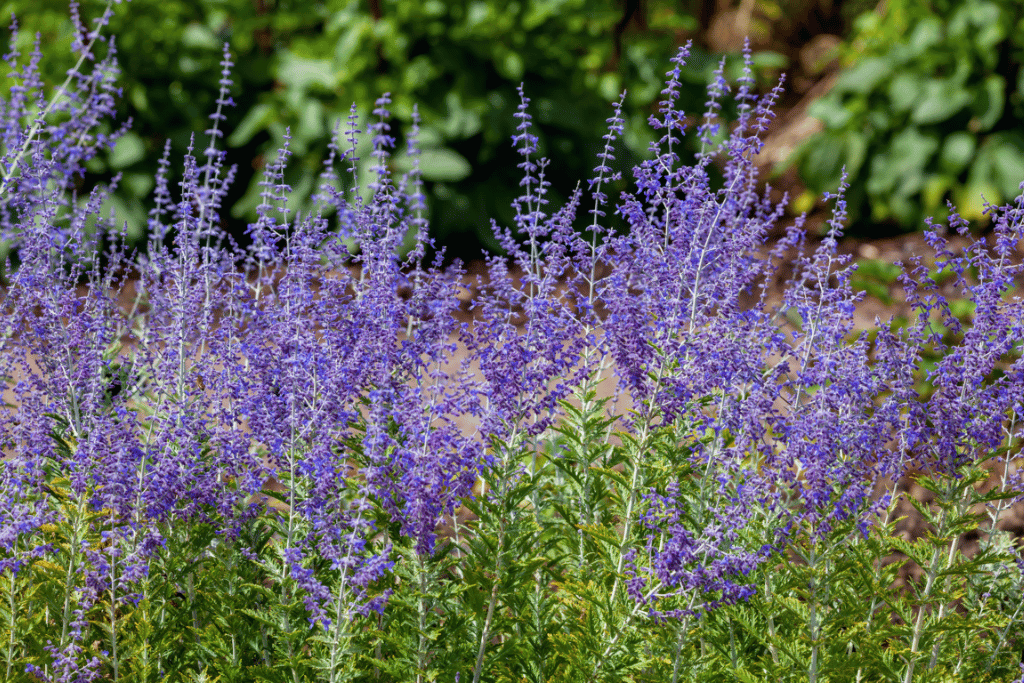
Russian sage is a plant with some serious pizzazz! This herbaceous perennial is a head-turner in the garden and showcases silvery gray foliage and spikes with blue-purple flowers that look like Lavender.
One characteristic distinguishing the Russian sage from Lavender is its leaf shape and size. While Lavender has narrow spear-shaped leaves that grow in opposing pairs, Russian sage has more elongated almost triangular leaves that are larger and more heavily textured.
Despite its difference from lavender, Russian sage is still a popular choice among gardeners who want to add a touch of elegance to their landscape. In addition to its ornamental value, Russian sage also has some practical uses too.
For example, the leaves can be dried out and used in potpourri, sachets, and other fragrant projects. Some people even use its leaves to make a soothing tea that is said to have a calming effect on the nerves.
- Common Name: Russian Sage
- Scientific name: Perovskia atriplicifolia
- Origin: Asia
- Family: Lamiaceae (Mint family)
- Type: Perennial Herbaceous shrub
- USDA Hardiness Zone: 5-9
- Temperature: -20 – 110F (-29 -43C)
- Humidity: 40-60%
- Soil: pH 6.5-7.5
- Light: Full Sun
- Fertilizer: 10-10-10 NPK
- Size: 3- 5 feet (90-1500cm) Tall / 2-4 feet (60-1200cm) Wide
2. Catmint
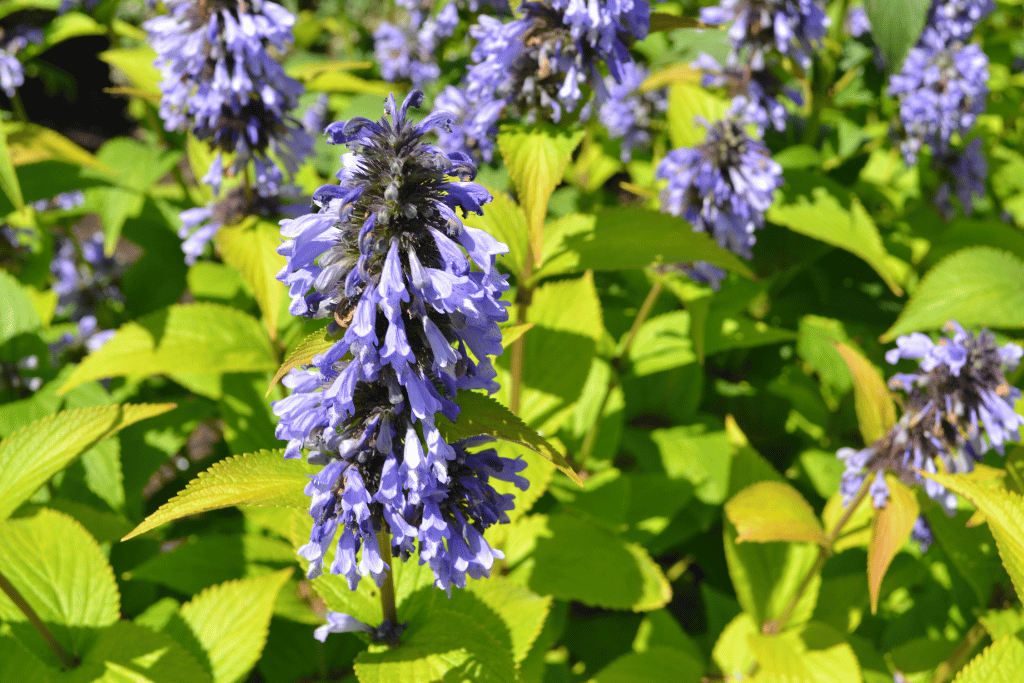
Catmint is the famous herb that drives our feline friends crazy! This member of the mint family has a distinctive scent and flavor that cats just can’t resist, making it a popular choice for pet owners who want to give their furry companions a little bit of fun.
Catmint isn’t just for cats though; it has some beneficial properties for humans too. You can brew the plants into a tea that is said to have calming effects on the nerves and promote relaxation- quite the opposite of what it does to cats eh!
Some people also use this common herb as a natural insect repellant or to soothe the skin from irritations and inflammation.
So, what’s the difference between Catmint and lavender? One thing that sets these two plants apart is the leaf shape and size. Lavender has narrow spear-shaped leaves, whereas Catmint leaves are more rounded and heart-shaped with a slightly toothed edge. The leaves are somewhat larger than lavender leaves and have a soft velvety texture that is pleasant to touch.
Beware, if you plant this in your garden, the seeds spread like crazy, and you can end up with little shoots of it in places you don’t want!
- Common Name: Catmint, Catnip
- Scientific name: Nepeta cataria
- Origin: Europe, Asia, Africa
- Family: Lamiaceae (mint family)
- Type: Perennial Herbaceous shrub
- USDA Hardiness Zone:3-9
- Temperature: -30-100F (-34-38C)
- Humidity: 40-60%
- Soil: pH 6.0-7.5
- Light: Full Sun to Part Shade
- Fertilizer:10-10-10 NPK
- Size: 2-3 feet (60-90cm) tall / 2-3 feet (60-90cm) wide
3. Lavender Cotton
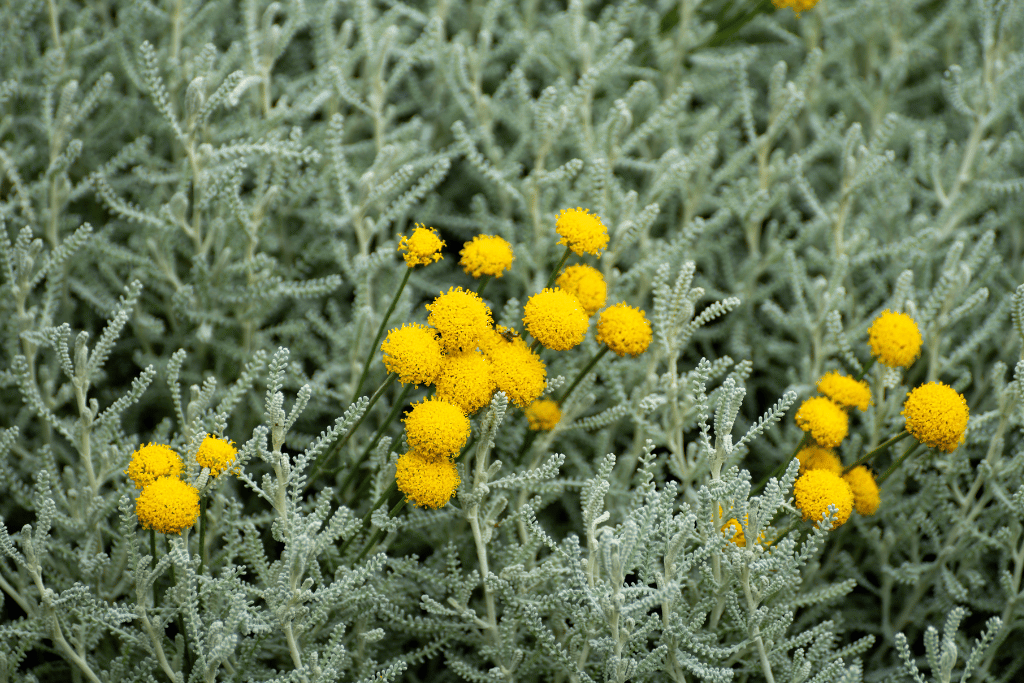
Next on the list is Lavender cotton. With a name like that, it’s sure to get your attention! This herbaceous perennial has a unique look and feel that stands apart from other plants in your garden.
One thing that distinguishes Lavender cotton from its look-alike is its leaf structure. Lavender cotton has much broader, almost fan-like leaves with deep lobes and a fine texture. The leaves are the same gray-green color as lavender, but the flowers are yellow, which makes an excellent complement to the foliage.
Speaking of the flowers, the Lavender cotton flowers are small and rounded in shape, more similar to a chrysanthemum than a lavender. The flowers don’t hold the same fragrance as Lavender, but they do have a subtle aroma that is pleasing and refreshing.
When it comes to the use of Lavender cotton, many people have used it as an insect repellent. The leaves of this plant contain a compound called Santolina which is said to repel pests like moths and mosquitos. If you are like me and get eaten alive by mossies in the summer- this plant would be great in a pot on the patio!
- Common Name: Lavender Cotton
- Scientific name: Santolina chamaecyparissus
- Origin: Western Mediterranean
- Family: Asteraceae (Daisy Family)
- Type: Perennial shrub
- USDA Hardiness Zone: 6-9
- Temperature: -10-110F (-23-43C)
- Humidity:40-60%
- Soil: pH 6.0-7.5
- Light: Full Sun
- Fertilizer: 10-10-10 NPK
- Size: 1-2 feet (30-60cm) tall / 1-2 feet (30-60cm) wide
4. Hyssop
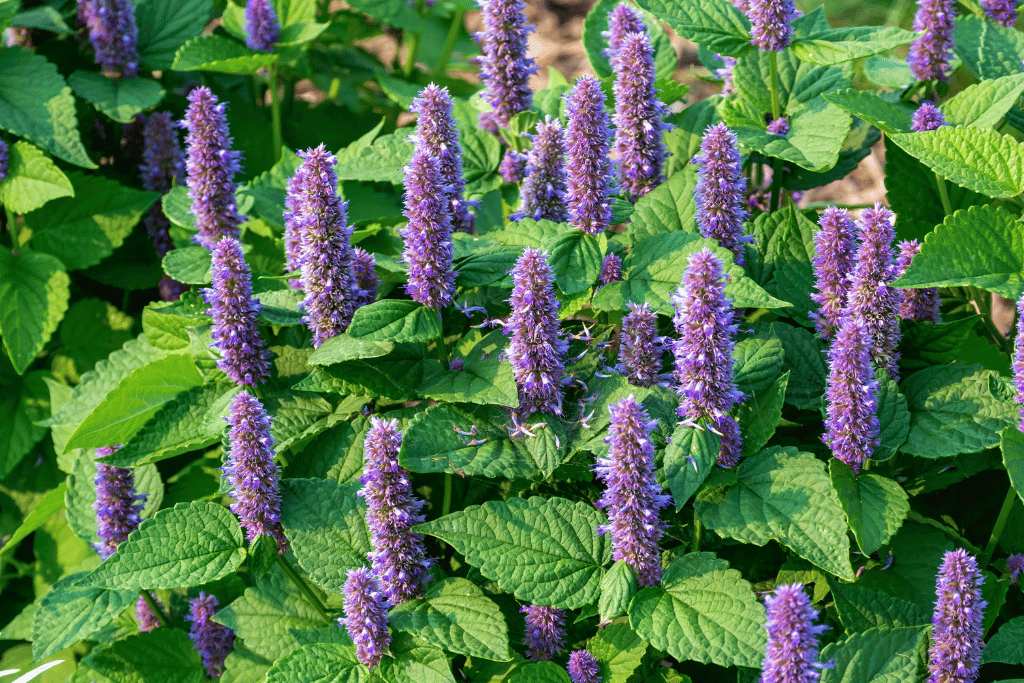
This plant has a long history in herbal medicine and culinary arts use. It’s an herbaceous perennial that’s been used for centuries as a natural remedy for anxiety, colds, coughs, and digestive issues. In the kitchen, its minty licorice-like flavor is used on meats and stews or even adds a refreshing note to teas and cocktails.
So how does this Lavender look-alike differ from the real deal? The leaves of Hyssop are deep green and broadly ovate with toothed margins. The dark green leaves hold a slightly bitter taste and spicy fragrance.
Hyssop flowers are small and tubular and similar to lavender ones but on a smaller scale. They are often a deep blue-purple color, although some cultivars may have pink, white, or red flowers. Like Lavender, the flowers are clustered along the stem, creating dense spike-like fluorescence. Hyssop flowers allure bees and butterflies, making them a great asset in your garden.
One of the exciting details about Hyssop for me is that it has been used in some religious and spiritual practices. Some cultures believe Hyssop has purifying properties and is used for cleansing and blessing ceremonies. It is also seen as a protection to ward off evil spirits- definitely a must-have by your home’s front door or entryway!
- Common Name: Hyssop
- Scientific name: Hyssop officinalis
- Origin: Mediterranean Western Asia
- Family: Lamiaceae (mint family)
- Type: Perennial Herbaceous plant
- USDA Hardiness Zone: 4-10
- Temperature: -30-100F (-34 – 38C)
- Humidity: 40-60%
- Soil: pH 6.0-7.5
- Light: Full Sun
- Fertilizer: 10-10-10 NPK
- Size: 1-2 feet (30-60cm) tall / 1-2 feet (30-60cm) wide
5. Rosemary
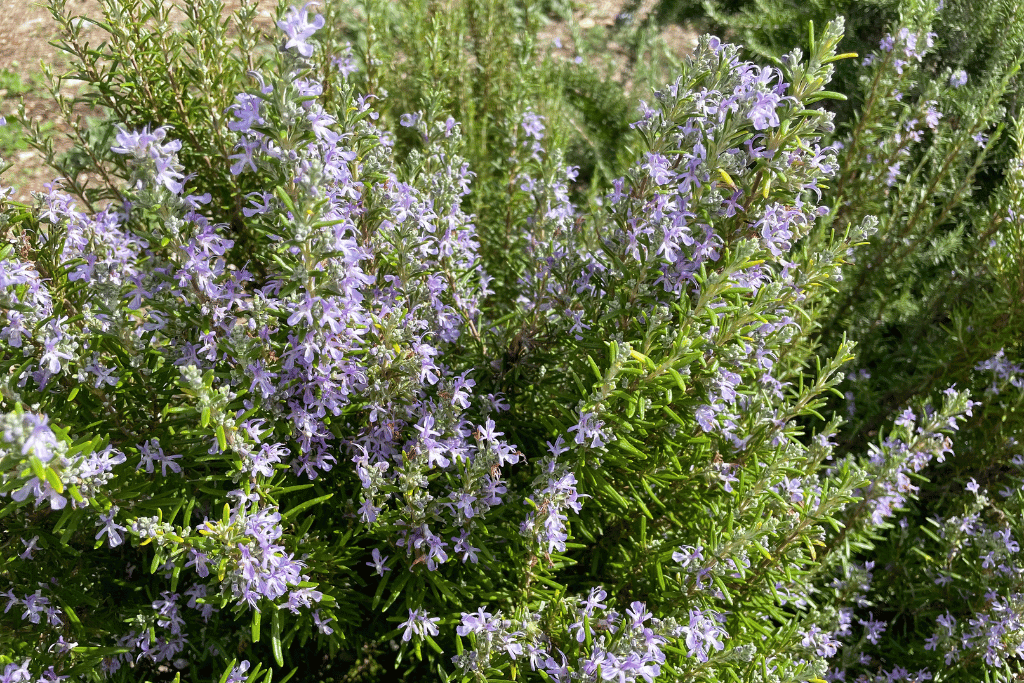
Rosemary smells like heaven and tastes like a dream- especially on roast potatoes! This perennial herb is often mistaken for Lavender, mainly due to their similar needle-like foliage and purple clustered flowers that bloom on a spike.
I think Rosemary flowers are less showy than Lavender – because they seem to have smaller petal structures and fewer ruffles! These herbs hold entirely different aromas and flavors, though. Rosemary has a robust earthy flavor, while Lavender has a floral, slightly sweet flavor. This culinary favorite can grow up to 6 feet (182cm) tall in the right conditions and holds several health benefits too.
Rosemary has large claims in the medicinal herb world, including improving digestion, reducing inflammation and boosting memory and concentration. We could all use a little bit of that occasionally! Not to mention Its essential oils are used in various products, from soap and shampoos to candles and room sprays.
- Common Name: Rosemary
- Scientific name: Rosemary officinalis
- Origin: Mediterranean
- Family: Lamiaceae (mint family)
- Type: Evergreen perennial
- USDA Hardiness Zone: 7-10
- Temperature: 10-100F (-12-38C)
- Humidity: 40-60%
- Soil: pH 6.0-7.5
- Light: Full Sun
- Fertilizer: 10-10-10 NPK
- Size: 4 Feet (1200cm) tall / 4 Feet (1200cm) wide
6. Perennial Sage
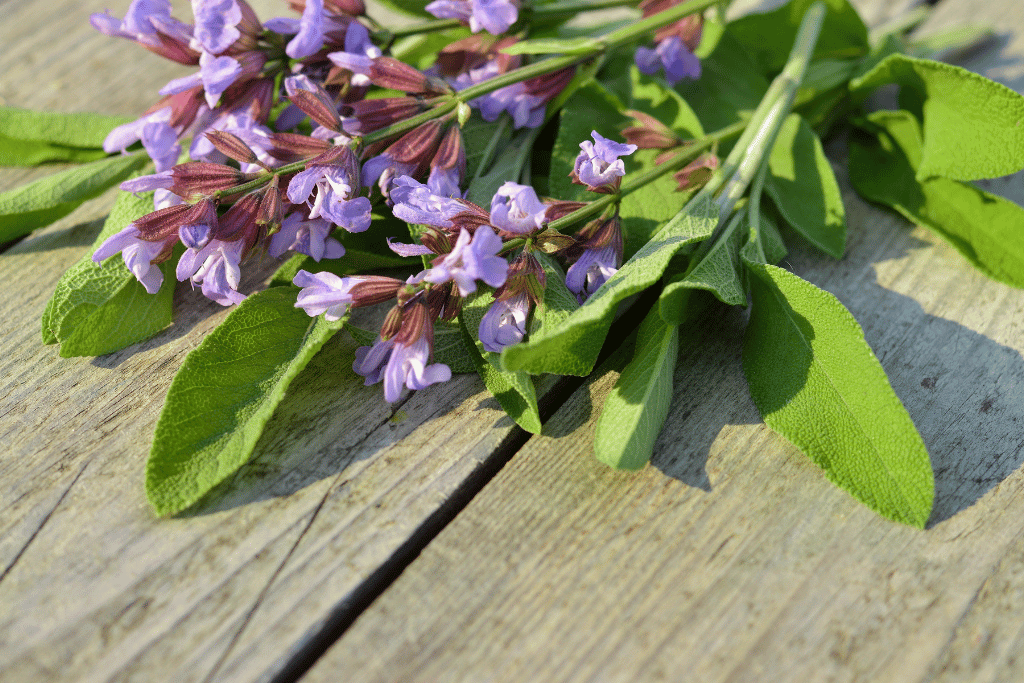
Perennial sage is a real tough cookie in the herbaceous plant world, as it can survive many years in harsh weather conditions. This herb has many interesting uses in traditional medicine, religious rituals, and the typical household kitchen.
This is not the most convincing lavender wannabe, but some people may need clarification on the two because of their green-gray foliage. Lavender and Perennial sage belong to the same family, so it’s no wonder they have similar characteristics.
The leaves of the Perennial sage are silvery green and have a pretty fuzzy texture- like tiny goosebumps!
The flowers of Perennial sage are quite beautiful and can be found in shades of pink, purple, and blue. They are arranged in whorls around the stem and are typically only ½ an inch (1.2cm) long. When they are all opened together, they look quite striking.
The Perennial sage is a practical plant to have in the garden for culinary purposes, and the flowers attract a whole load of pollinators to the garden, like hummingbird butterflies and bees. Seeing these buzzing around your garden mid-spring is always a great sign!
- Common Name: Perennial Sage
- Scientific name: Salvia spp.
- Origin: Mediterranean, Central and South America and Asia
- Family: Lamiaceae (mint family)
- Type: Perennial Herbaceous
- USDA Hardiness Zone: 4-9
- Temperature: -30-100F (-34- 38C)
- Humidity: 40-60%
- Soil: pH 6.0-7.5
- Light: Full Sun
- Fertilizer: 10-10-10 NPK
- Size: 2-3 Feet (60-90cm) tall and 2-4 Feet (60-1200cm) Wide
7. Mexican Bush Sage
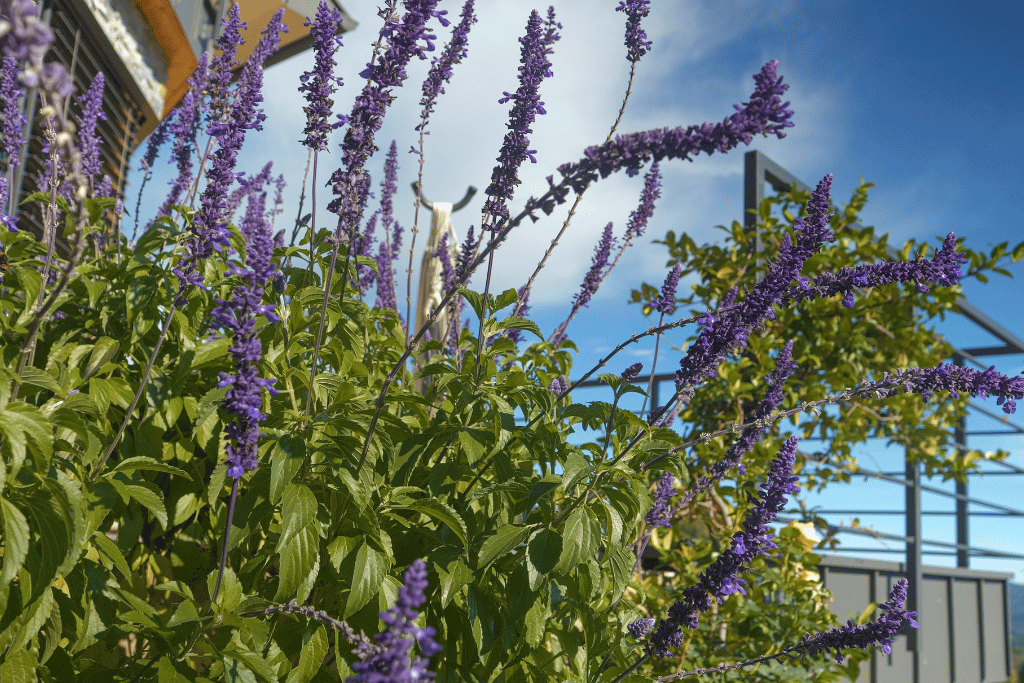
If you’re looking for a hardy, low-maintenance plant similar to Lavender but with a bit of a twist, the Mexican bush sage might be just what you need. This stunning plant is known for its striking purple blooms and ability to attract butterflies, bees, and other pollinators to the garden.
Mexican bush sage has long slender leaves that are silvery green with a slightly furry texture. The leaves are somewhat broader than Lavender leaves and have a more robust surface. The plant holds a hint of a minty aroma when crushed and, for that reason, has been used in the kitchen to add flavor to many dishes. This is not the average sage shrub though; it can reach a height of 4-6 feet (121-182cm) or more which is quite a difference compared to Lavender.
Another key feature that differentiates the Mexican bush sage from Lavender is the size of the flower spikes. Although the Mexican Bush sage blooms similarly to Lavender, the spikes can reach over a foot long, making them look more prominent than Lavender.
- Common Name: Mexican Bush sage
- Scientific name:Salvia Lucantha
- Origin: Mexico and South America
- Family: Lamiaceae (mint family)
- Type: Perennial Shrub
- USDA Hardiness Zone: 8-11
- Temperature: 70-90F
- Humidity: 40-60%
- Soil: pH 6.0-7.5
- Light: Full Sun
- Fertilizer: 10-10-10 NPK
- Size: 3-4 Feet Tall and Wide
Almost Lavender but With a Twist
There you have seven plants that look like Lavender but aren’t. You probably realize why these all look so similar to Lavender – because most of them belong to the same family. The mint family of plants holds almost identical characteristics, like the purple flower spike and silvery gray foliage.
That said, the smell and taste of these different species can vary significantly.
Whether you’re hunting for a Lavender-looking shrub for a flower bed or are after a plant to deter mosquitoes, you will surely find one of these seven plants to suit your needs.
Thirsty for More Info on Plants That Could Pass for Others?
Don’t let the grass grow under your feet- stick around our website for more juicy details on these sneaky look-alikes. We have plenty of plant-related tidbits to make your green thumb tingle joyfully!


